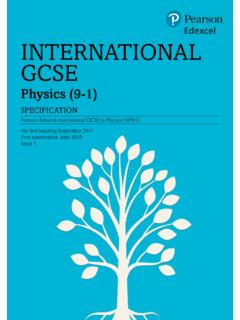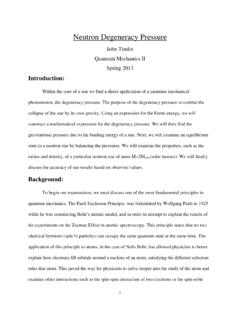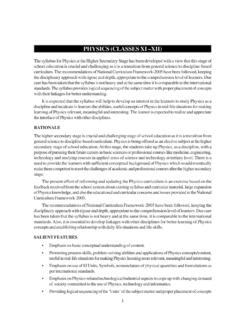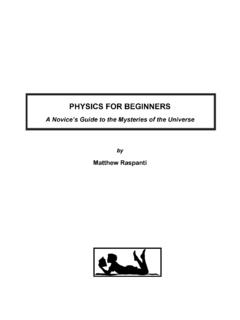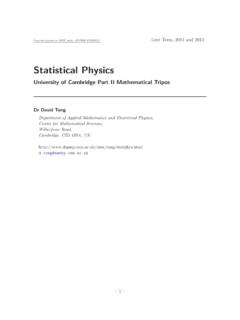Transcription of The Photoelectric Effect & Its Applications
1 2005 Yerkes Summer Institute Photoelectric Effect Lab 1 The Photoelectric Effect & Its Applications Robert B. Friedman & Rick Kessler Background & Purpose What Is The Photoelectric Effect ? What is the Photoelectric Effect ? In short, when light illuminates a piece of metal, the light will kick off electrons from the metal s surface and these electrons can be detected as a change in the electric charge of the metal or as an electric current. Hence the name: photo for light and electric for the current. The explanation behind this simple phenomenon opened the door to revolutionary modern physics concepts regarding the composition of light, quantum mechanics, and what is now referred to as the wave-particle duality of nature.
2 The wave-particle duality of nature is perhaps one of the greatest mysteries of our universe and a very interesting philosophical subject! Your goal in this lab is to reproduce the Photoelectric Effect for yourselves and understand how it demonstrates the particle behavior of light. The physics of Light Right Before 1905 By the end of the 19th century (1800s) physicists believed that they had a firm understanding of electricity, magnetism, gravity and mechanics. Furthermore, the hot debate over whether light was composed of particles or waves was all but over with the consensus leaning towards a wave description. Scientists such as Fresnel were able to show that light would reflect, refract, diffract and interfere just like any other wave such as water or sound.
3 Furthermore, a famous theoretical physicist by the name of James Clerk Maxwell was able to show that light is made by fluctuations in electric and magnetic forces; hence light was understood to be a form of electromagnetic (EM) radiation. He showed that these EM force fluctuations could travel through space like waves on water. So if an electron were sitting somewhere in space and such a wave passed, the electron would bob up and down like a boat on rough seas. This description seemed sufficient to explain what light was. The theories of physics developed up to that time, including the EM wave model of light, are now called the classical model. The Ultraviolet Catastrophe Yet, not all was well.
4 In particular there was one very nagging dilemma known as the ultraviolet catastrophe. The catastrophe was the startling and counter-intuitive result that using the classical model of light to theoretically calculate the total energy radiated away by a hot object gave an infinite energy ! The term ultraviolet is there because this infinite energy came from the fact that the shorter the wavelength of the light one looked at, the more of that light the object seemed to be giving off! So when someone started adding up these energies, the contribution for the higher energy , shorter wavelength light became larger and larger without end. This infinite energy calculation didn t make any sense and it didn t match observations and experiments.
5 An analogy to this dilemma is trying to determine the number of fish in the sea. If you think that the smaller the size of a fish, the more fish of that size there are, you could estimate the number of fish in the sea. But, if you think fish can get smaller and smaller and smaller, you would be lead to the conclusion that there were an endless number of fish because as you got to smaller and smaller fish, there would be more and more to count. Of course, this is not the case in reality because at some point fish cannot get any smaller so there is an end to what you are trying to count; there is a smallest fish . 2005 Yerkes Summer Institute Photoelectric Effect Lab 2 A physicist named Max Planck realized that if light had some smallest energy , then the ultraviolet catastrophe was no longer a problem: the theory and data could be reconciled.
6 However, As a historical note, Planck did not believe that radiation could really have a smallest energy , and assumed that his mathematical trick for avoiding the UV catastrophe was not a feature of the true nature of light. The Photoelectric Effect Mystery Another dilemma was how to properly explain the Photoelectric Effect . Around the same time, physicists knew that if one were to shine an ultraviolet light onto a charged metal plate in a vacuum, the metal plate would lose its charge. The brighter the UV light, the faster the plate lost its charge. Yet, it appeared that the same was not true for longer-wavelength light. One could not discharge a negatively charged metal plate with long wavelength light.
7 It didn t even matter how bright the long wavelength light was, it had no Effect . This observation was strange to say the least, especially if the classical model of light was right. In the classical model, the energy of an EM wave depends only on the amplitude (height) of the wave. Think about it this way: the bigger the amplitude of a wave on a lake, the higher it will rock your boat up and down and you will claim that the intensity of the rocking is greater. Well, it certainly requires more energy to rock your boat higher and higher, so it s not hard to believe that the energy of a wave depends on its amplitude. It is an important fact that the energy of a classical wave only depends on the amplitude and not the wavelength.
8 This phenomenon of wave behavior, if true for light, contradicts the observations of the Photoelectric Effect . The classical model claims that if the intensity (brightness) of light is increased, then the energy of the light will increase, regardless of the light s wavelength. But, why was it impossible to discharge the metal with very intense long wavelength light?? The Photoelectric Effect Explained! ( .. is worth a Nobel Prize .. ) Einstein realized that Planck s trick to avoid the UV catastrophe was more than just some trick. In 1905 Einstein published an important paper on Planck s idea and his explanation of the Photoelectric Effect . He made the important and unobvious assumption that Planck s trick was the true nature of light.
9 Einstein claimed that light was made of particles called quanta, that each had some small fixed energy which depended on the wavelength of the light. The shorter the wavelength, the more energy each of these quanta had, the longer the wavelength the smaller the energy of the quanta. So quanta of red light would have less energy than quanta of blue light. This was very different from the classical model; it was the birth of what is called the quantum model. Einstein also reasoned that light should behave and interact like any other particle! It was pretty well understood that when the negative metal plate discharged, it was losing negative electrons from its surface.
10 It was originally believed that when the EM wave hit the plate, the incident radiation caused the electrons in the metal to jiggle. It was also believed that if the wave had enough energy ( a large-enough amplitude) it could jiggle the electrons right off the metal. Einstein suggested another scenario: that the light quanta would each strike an electron, like one billiard ball hitting another. If a quantum of light had enough energy then it would knock the electron off, but if the light quantum did not have sufficient energy , then the electron would jiggle a little in the metal but remain attached. This description was enough to both explain the weird wavelength-dependent behavior observed and to make some observable predictions.
